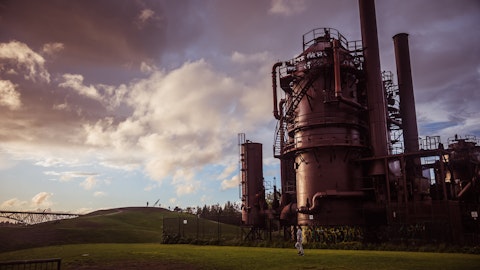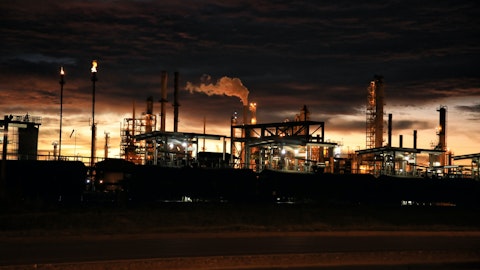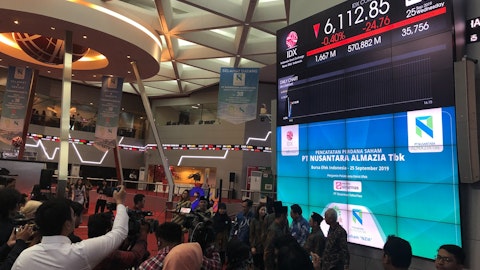ConocoPhillips (NYSE:COP) Q4 2022 Earnings Call Transcript February 2, 2023
Operator: Welcome to the Q4 2022 ConocoPhillips Earnings Conference Call. My name is Michelle and I will be your operator for today’s call. I will now turn the call over to Phil Gresh, Vice President, Investor Relations. Sir, you may begin.
Phil Gresh: Yes. Thank you, operator and welcome to everyone joining us for our fourth quarter 2022 earnings conference call. On the call today are several members of the ConocoPhillips’ leadership team, including Ryan Lance, Chairman and CEO; Bill Bullock, Executive Vice President and Chief Financial Officer; Dominic Macklon, Executive Vice President of Strategy, Sustainability and Technology; Nick Olds, Executive Vice President of Lower 48; Andy O’Brien, Senior Vice President of Global Operations; and Tim Leach, advisor to the CEO. Ryan and Bill will kick off the call with opening remarks, after which the team will be available for your questions. A few quick reminders. First, along with today’s release, we published supplemental financial materials and a presentation which you can find on our Investor Relations website.
Second, during this call, we will be making forward-looking statements based on current expectations. Actual results may differ due to factors noted in today’s release and in our periodic SEC filings. Finally, to make we will make reference to some non-GAAP financial measures. Reconciliations to the nearest corresponding GAAP measure can be found in today’s release and on our website. With that, I will turn the call over to Ryan.
Ryan Lance: Thanks, Phil and thank you to everyone for joining our fourth quarter 2022 earnings conference call. As we sit here today, there are a number of cross currents in the global economy. While the energy sector is not immune to potential macro headwinds, our fundamental outlook remains constructive. On the demand side, we think that growth will continue in 2023 aided by normalization in China mobility following the loosening of COVID restrictions. On the supply side, we believe the continued producer discipline and the expected impacts of Russian oil and product sanctions are likely to keep balances tight. So while commodity prices are currently not as high as they averaged in 2022, we see duration to this up-cycle. Now stepping back, we remain steadfast in our view that a successful energy transition must meet society’s fundamental need for secure, reliable and affordable energy while also progressing toward a lower carbon future.
While we all recognize the challenges that global energy policymakers face to achieve the goals of the Paris Agreement, it is clear that doing so requires an all-the-above approach. This can be done by enacting policies that encourage the development of lower emission energy sources and oil and gas resources. These policies should include efforts aimed at fiscal stability, streamlining of the permitting process, increased transparency on timelines and supporting critical infrastructure. These are not just necessary for the oil and gas industry, but also for nuclear, hydrogen and renewables, all of which will be necessary to deliver on the energy transition. At the end of the day, it’s critical for our administration to remember that North American energy production is stabilizing for us for both global energy security and meeting energy transition demand.

Photo by American Public Power Association on Unsplash
Meeting that demand will require investments in medium and long-cycle projects in addition to short-cycle U.S. shale. This is why you see ConocoPhillips leaning a bit further across our deep and diversified portfolio in 2023, whether it’s the Lower 48, where we achieved record production in 2022 or our diversified global portfolio, ConocoPhillips is well positioned to meet the world’s long-term energy needs while also reducing our own emissions footprint. Shifting to our 2022 performance, ConocoPhillips showed continuous strong execution across our triple mandate. We generated a trailing 12-month return on capital employed of 27%, the highest since the spin. We delivered on our plan to return $15 billion of capital to our shareholders, which represented 53% of our CFO, well in excess of our greater than 30% annual through-the-cycle commitment and we further advanced our net zero operational emissions ambition with a new medium-term methane intensity target consistent with our recent commitment to joining OGMP 2.0. Now looking ahead, ConocoPhillips is well positioned to further deliver on our triple mandate in 2023 with a well-balanced capital allocation strategy.
This morning, we announced a plan to return $11 billion of capital to shareholders, which represents about 50% of our forecasted CFO at $80 WTI. The other half of our cash flow will be dedicated to reinvesting in the business. From a portfolio perspective, our deep and well-diversified asset base is well-positioned to generate solid cash flow growth for decades to come. This is further evidenced by our organic reserve replacement ratio of 177% in 2022. We are also enthusiastic about our new LNG opportunities we are participating in, in Qatar and the United States, which are highly complementary to our existing LNG business. And we look forward to providing you a comprehensive update about our long-term strategy and our financial outlook at our upcoming Analyst and Investor Meeting on April 12 at the New York Stock Exchange.
Now, let me turn the call over to Bill to cover our fourth quarter performance and 2023 guidance in a bit more detail.
Bill Bullock: Thanks, Ryan. Starting with fourth quarter results, we generated $2.71 in adjusted earnings per share. Fourth quarter production was 1,758,000 barrels of oil equivalent per day, which included a 27,000 barrel a day negative impact from weather in the Lower 48. Lower 48 production averaged 997,000, including 671,000 from the Permian, 214,000 from the Eagle Ford, and 96,000 from the Bakken. Moving to cash flow. Fourth quarter CFO was $6.5 billion, excluding working capital at an average WTI price of $83 per barrel. APLNG distributions were $639 million and fourth quarter capital expenditures were $2.5 billion, including $2.1 billion of base capital and $300 million for acquisitions and North Field East payments. On capital allocation, we returned $5.1 billion to shareholders through ordinary dividends, VROC payments and share buybacks, while also reducing gross debt by $400 million.
Full year CFO was $28.5 billion, excluding working capital at an average WTI price of $94 per barrel in 2022. Full year APLNG distributions were $2.2 billion and full year total CapEx was $10.2 billion with base CapEx achieving our guidance of $8.1 billion and $2.1 billion of acquisitions in North Field East payments. Full year return of capital was $15 billion, while $3.4 billion went to debt reduction with cash and short-term investments ending the year at $9.5 billion. Turning to 2023 guidance, we forecast full year production will be in a range of 1.76 million to 1.8 million barrels of oil equivalent per day, which represents 1% to 4% of organic growth. Our first quarter production guidance range is 1.72 million to 1.76 million, which includes $35,000 of planned maintenance, primarily in Qatar and the Lower 48.
Our full year planned maintenance is expected to be similar to 2022. On capital spending, we expect a range of $10.7 billion to $11.3 billion, which I will discuss in more detail in a moment. We expect operating costs of $8.2 billion, DD&A of $8.1 billion, and corporate segment net loss of $900 million. For 2023 cash flow, we forecast $22 billion in CFO at $80 barrel WTI, $85 Brent and $325 Henry Hub at current strip prices for regional differentials. Included in our cash flow forecast is $1.9 billion in APLNG distributions with $600 million expected in the first quarter. Now regarding CapEx, we provide a waterfall in our prepared materials bridging 2022 actual spending to 2023 guidance. Starting with base capital spending, we forecast an increase from $8.1 billion in 2022 to a range of $9.1 billion to $9.3 billion in 2023.
The remaining $1.6 billion to $2.0 billion is allocated to longer term projects. Of this amount, $1.5 billion to $1.6 billion is for LNG projects, which includes Port Arthur, North Field East and North Field South. For Port Arthur specifically, after factoring in expected project financing, we forecast that ConocoPhillips net investment will be just under $2 billion over the 5-year investment period. However, more than half of this capital investment will be in 2023. For Willow, we are guiding to $100 million to $400 million of incremental spending with the higher end of this range, assuming that the project is sanctioned this year. In summary, we are happy with our strong 2022 results, which would not be possible without the hard work and dedication of our talented workforce.
And we are well positioned to balance investing in our deep and diversified portfolio this year while also continuing to return capital to our shareholders. That concludes our prepared remarks. I will now turn the call back over to Phil.
Phil Gresh: Great. Thanks, Bill. As a reminder, just before we go to the Q&A, we ask that you please keep it to one question and a follow-up. With that, Michelle, we are ready to turn over to you for Q&A.
See also 25 Lowest PE Stocks of S&P 500 Index and 11 Most Undervalued Blue Chip Stocks To Buy .
Q&A Session
Follow Conocophillips (NYSE:COP)
Follow Conocophillips (NYSE:COP)
Operator: Thank you. Our first question will come from Neil Mehta with Goldman Sachs. Your line is now open.
Neil Mehta: Yes, good morning team and thanks for taking the time. Our first question is around Willow and recognize there is still some gating factors to getting it towards FID, but it seems to be moving in the right direction. So just talk about how you are thinking about that project, what remains outstanding to get it to FID? And then any thoughts on costs as well, the latest number we have is $8 billion all-in. Is that still good to go by or how should we think about that?
Andy O’Brien: Hey, Neil, this is Andy. Yes, there has been a lot of moving parts on Willow since the last earnings call. So let me just step through where we are in the overall approval process and then I can clear where we are with CapEx and scope. So with the approval process, I think most people saw that the final supplemental environmental impact statement was released by the Biden administration earlier this week. Now that should be published in the federal register in the next day or so and then that starts the required 30-day clock before the ROD can be issued. Now given the Biden administration’s commitment to the Alaska congressional delegation, we then expect to receive that ROD in the first week of March. Once the ROD has been issued, our focus for 2023 will be to immediately initiate gravel road construction, ramp up fabrication and supply chain activities.
Now we are going to need to take a look at the ROD in some detail, but assuming it’s consistent with the BLM’s 3-pad preferred alternative and there are no new unworkable restrictions added, we would then proceed to final investment decision. So switching to CapEx, 2023 is very dependent on the ROD timing. And as Bill mentioned, we have given a range. So with the ROD timing, any resolutions of outstanding issues, what we are guiding is about $100 million to $400 million of incremental spend in 2023. In terms of the total project costs, we have recently gone out to market to update our cost estimates and we have seen some inflationary pressures. We have also refined the scope, including an update to accommodate the BLM’s 3-pad preferred alternative.
So we are in the process of finalizing our cost estimates, but we would anticipate the AFE to first production to be in the $7 billion to $7.5 billion range. Of the increase versus the update we provided in 2021, it’s been about 50-50 between inflation and scope refinement. So hope that gives you a pretty good update on where we are with Willow. And then at our April Investor Day, we will be happy go into some more details.
Neil Mehta: And that 7.5%, Andy, compares to the 6% before it sounds like, it would be the apples-to-apples. And then…
Andy O’Brien: That’s correct. That’s an apples.
Neil Mehta: Okay, that’s great. And then the follow-up is just around return of capital. Last year was an outstanding year, 53% back to shareholders and of the cash flow and the guidance this year, $11 billion also implies a very strong return of capital number. I know we often anchored to the 30% or greater than 30%, but is the message we should be interpreting that there is a new normal here around return of capital and the bar has been reset higher?





